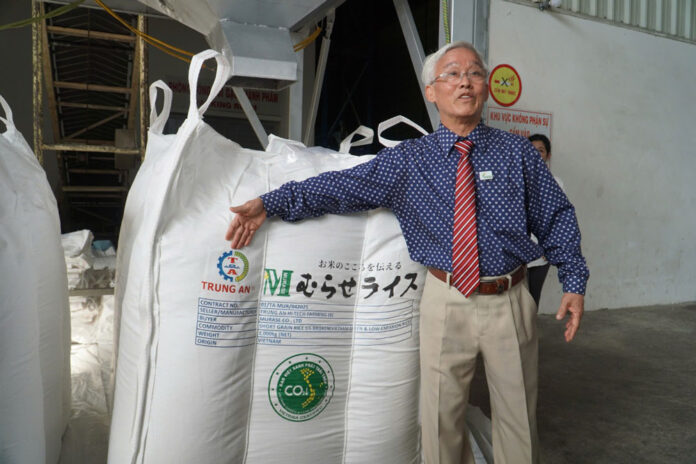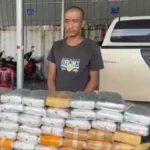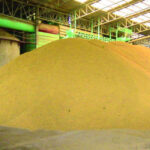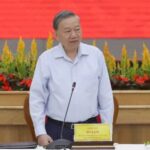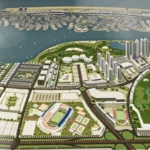Amid soaring rice prices in Japan, which have doubled compared to the same period in 2024, empty shelves, and record-low national reserves, Trung An High-Tech Agriculture Joint Stock Company, in collaboration with the Vietnam Rice Association (VIETRISA), has successfully exported a batch of 500 tons of rice branded as “Low-Emission Green Vietnamese Rice” to Japan, selling at $820/ton.
Huge Demand
This event marks the entry of rice from the “Project for Sustainable Development of 1 Million Hectares of High-Quality and Low-Emission Rice in the Mekong Delta until 2030” (the 1 Million Hectares of Rice Project) with the brand name “Low-Emission Green Vietnamese Rice” into the export market.
Mr. Pham Thai Binh, Director of Trung An Company, shared: “The company has partnered with Murase Group (Japan) in cultivating many high-quality rice varieties in the Mekong Delta. In 2024, the two sides continued to upgrade their cooperation to grow various types of rice under the ‘Low-Emission Green Vietnamese Rice’ standard according to the 1 Million Hectares of Rice Project. The aforementioned first export batch is part of the 20,000 tons recognized with this label.”
Mr. Binh assessed that there is a huge demand in the Japanese market, especially if the rice is grown according to the linkage model of the 1 Million Hectares of Rice Project. However, the representative of Trung An Company emphasized that ensuring the production process is most important. “Up to this point, sufficient conditions have been met to widely implement the 1 Million Hectares of Rice Project, instead of just piloting it on a small scale of 5 or 10 hectares. Therefore, in the future, when the localities complete the arrangement, the managing agency needs to quickly approve the projects on low-emission rice cultivation of enterprises and cooperatives,” said Mr. Binh.
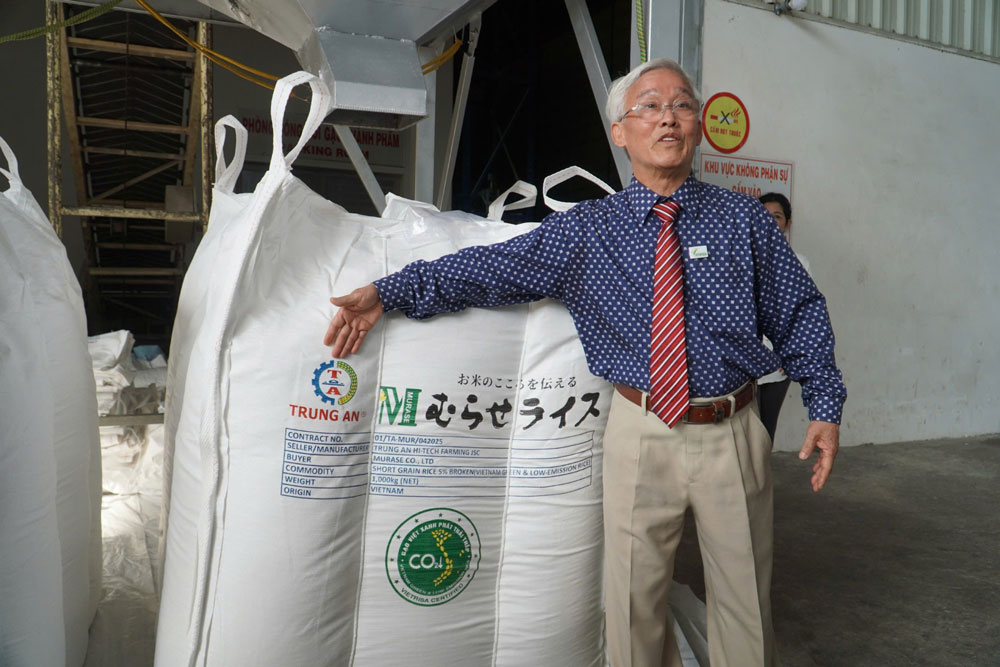
The first batch of “Low-Emission Green Vietnamese Rice” from Trung An Company exported to Japan. Photo: CA LINH
According to Associate Professor Dr. Bui Ba Bong, Chairman of VIETRISA, the association has built the brand name “Low-Emission Green Vietnamese Rice” with the coordination and support of agencies from the Ministry of Agriculture and Environment, and international organizations including the International Rice Research Institute (IRRI), the Dutch Development Organization, and the World Bank.
Currently, VIETRISA has completed the construction and promulgation of the regulations on the use of the brand name “Low-Emission Green Vietnamese Rice”. VIETRISA has been granted the right to use this brand name for 7 enterprises with a total rice volume of 19,200 tons by the “Transforming the Rice Value Chain to Respond to Climate Change and Sustainable Development in the Mekong Delta Region” Project (TRVC). Trung An Company is the first enterprise to export a batch of rice with this brand name to Japan.
Historical Opportunity
Also, according to Mr. Pham Thai Binh, the Vietnamese rice industry is facing a historical opportunity to affirm its position in the international market. The cooperation between the government, international organizations, local authorities, and the crucial role of farmers and cooperatives create a strong driving force. This is a favorable time to enhance the reputation of Vietnamese rice and thereby position our agricultural products on the world map.
Mr. Nguyen Van Thanh, Director of Phuoc Thanh IV Trading Production Company, said that Vietnam has a good rice variety portfolio, meeting the demands of many large markets such as Japan, the Middle East, and the EU. However, participating in exports is a long story that needs to be associated with brand building. Currently, Phuoc Thanh IV Company has registered to participate in the low-emission rice cultivation program, but it is expected that it will not be able to export products until 2027.
Meanwhile, Ms. Nguyen Thi Tra My, Chairman of the Board of Directors of Vietnam Seed Joint Stock Company (Vinaseed), shared that the company’s orientation is to prioritize quality and focus on demanding markets. “The demand for rice consumption in Japan is good. The Board of Directors of Vinaseed has discussed and looked for ways to export rice to this market. We are confident in the quality and traceability from seeds to the dining table,” said Ms. My.
According to Ms. Tra My, Vinarice – a member of the Vinaseed Group – has participated in the TRVC Project of the Australian Government and received positive media effects. “We practice reduced emission cultivation in the provinces of the Mekong Delta, and as a result, in the first crop, we reduced 3,888 tons of CO2 and received a bonus of AUD 28,600,” said Ms. My.
Besides exports, Vinaseed also wants to focus more on the domestic market with packaged rice. “Currently, the market share of packaged rice in Vietnam is only 5%, while in Thailand, it is up to 60-70%. Therefore, we believe this is a great opportunity for Vinaseed,” said Ms. My.
Need for Replication
Statistics from the Ministry of Agriculture and Environment show that rice exports in the first five months of this year reached 4.5 million tons, earning $2.34 billion, up 12.2% in volume but down 8.9% in value compared to the same period.
According to Deputy Minister of Agriculture and Environment Phung Duc Tien, the review of the rice land planning shows that there are over 3.5 million hectares of rice land. Accordingly, if high yield and good quality are ensured, it will definitely solve food security and export issues. However, the rice industry needs to go deeper into the value chain and increase added value. Especially by effectively implementing the 1 Million Hectares of Rice Project. Rice production needs to follow a circular economic model, digital transformation, and aim to improve productivity and quality, ensuring compliance with cultivation processes, fertilizers, and plant protection drugs… thereby enhancing competitiveness.
According to Dr. Tran Minh Hai – Vice Principal of the School of Public Policy and Rural Development, it is necessary to research and replicate the model of the 1 Million Hectares of Rice Project in many areas of the Mekong Delta and other localities in the country that can explore and implement it. However, when replicating, it is necessary to solve the difficulties of investing in additional infrastructure and pump stations; attracting banks and enterprises to participate in the linkage model to consume products… If the scale is small, enterprises can consume the products, but for thousands of hectares, more capital is needed, requiring banks to accompany.
Mr. Cao Duc Phat, former Minister of Agriculture and Rural Development (now the Ministry of Agriculture and Environment), evaluated that “Low-Emission Green Vietnamese Rice” from the 1 Million Hectares of Rice Project not only helps farmers increase their income but also makes them proud to be contributors to global environmental protection. They are not only food producers but also “green warriors” in the fight against climate change.
Additional 200 Tons of ST25 Rice to Australia
According to Deputy Minister of Agriculture and Environment Tran Thanh Nam, the successful export of “Low-Emission Green Vietnamese Rice” proves that farmers have shifted from a pure production mindset to sustainable development, knowing how to efficiently exploit land while protecting soil health and increasing added value.
Uncovering the Illicit Drug Trade Route from the Golden Triangle to Vietnam
After a two-month-long investigation and surveillance operation, a special task force from the Dien Bien Province Public Security Department, in collaboration with the Public Security Forces of Northern Laos, successfully dismantled a large-scale illegal drug trafficking and transportation ring on June 9.
The King of Fruits: Thailand’s Agricultural Triumphs Set to Rival Vietnam’s Exports
“Thailand is ramping up its exports of two key agricultural commodities, rice and cassava, to China. This strategic move could potentially impact Vietnam’s market share in these sectors. With a focus on expanding their global reach, Thailand’s aggressive approach may spark a competitive response from Vietnam to maintain its foothold in the industry.”
“Spanish Prime Minister: Ready to Cooperate and Share High-Speed Rail Expertise with Vietnam”
On June 9, while attending the United Nations Ocean Conference in Nice, France, Prime Minister Pham Minh Chinh met with Spanish Prime Minister Pedro Sanchez.

